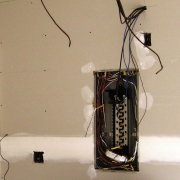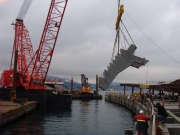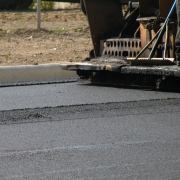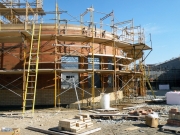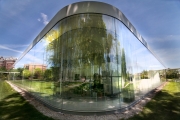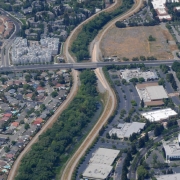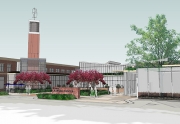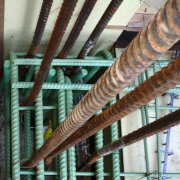Located across the street from SANAA’s Glass Pavilion at the Toledo Museum of Art is Frank Gehry’s Center for the Visual Arts. Completed in 1993 to house the University of Toledo Department of Art as well as the Toledo Museum of Art's Reference Library, the four story, L-shaped fortress like building is a prime example of postmodern Deconstructivism.
Jeff Wilson Everyday DIY Blog
Let's talk DIY
This is the place to rant, rave, brag, belly-ache, crack a joke, procrastinate, and delve into the metaphysical aspects of the DIY mindset. We’re off the map, on a tangent, and frequently off topic. This is the stuff we don’t show on TV.
Sprinkler System Installation Guide
Okay, the planning's done, you've bought all the parts, now you're in the yard, shovel in hand, ready to start. In this helpful video, we'll show you the steps to a perfect sprinkler system installation, including trenching, connecting the water source, installing shut-off valves, working with PVC pipe, building a valve manifold, connecting wires, installing sprinklers and flushing your system.
Panelboards
The National Electrical Code (NEC) defines a panelboard as "a single panel or group of panel units designed for assembly in the form of a single panel, including buses and automatic overcurrent devices, and equipped with or without switches for the control of light, heat, or power circuits; designed to be placed in a cabinet or cutout box placed in or against a wall or partition; and accessible only from the front" (Article 100-definitions).
Construction of the Vancouver Convention Centre's Habitat Skirt
The Vancouver Convention Centre, which was featured on the Go Green channel as a case study in April, has an extremely unique design feature – an artificial reef (also referred to as a “habitat skirt”). The concrete habitat skirt steps down in five tiers from the underside of the public walkway into the harbor. The skirt was designed with input from marine biologists and other consultants to make it mimic a natural environment.
Irrigation: Is Grass Greener on the Other Side?
Water is essential to grass. Healthy grass is composed of 75 - 85% water, and water assists with seed germination, maintaining plant temperature, and tissue development, along with food and nutrient processes. Without water, grass is susceptible to disease, will brown and wilt and, although very resilient, may die. Healthy, lush, green grass is achieved from thorough, regular watering, which develops deep, drought-resistant roots. The amount of water, frequency, and method of watering depends on where you live, what type of grass you grow, and how you approach completing the task. Common methods include manual watering and automatic sprinkler systems.
Asphalt Paving
While asphalt can occur in nature as a result of crude oil’s exposure to weather, the asphalt used today in modern paving is a by-product of the oil refining process. What is referred to as asphalt in modern construction is actually asphaltic cement concrete, a flexible paving material composed of a mixture of asphalt cement (the binder), aggregates, and fine aggregates such as sand. Asphalt concrete mixes can be prepared off-site as a plant mix, or mixed-in-place at the project site.
Scaffolding
Scaffolding has multiple functions and a variety of configurations, enabling it to meet the needs of virtually any construction or maintenance project. One function of a scaffolding system (sometimes referred to as staging) is to provide safe temporary access for workers and materials to an elevated area of a building, either interior or exterior, for construction, alteration, or routine maintenance or renovation activities. Scaffolding can also provide safe, temporary shoring for building materials and structural components. Scaffolding has evolved from the very early days of wooden and bamboo structures to sophisticated, and often elaborate, metal structures which require the services of a structural engineer. Without scaffolding, many construction and building repair activities would not be possible.
Pritzker Prize Worthy: SANAA's Glass Pavilion at the Toledo Museum of Art
By now you have probably heard that Kazuyo Sejima and Ryue Nishizawa, partners of the Japanese architectural firm SANAA, have been awarded the 2010 Pritzker Architecture Prize. Renowned for their elegant compositions that emphasize transparency and lightness through explorations in material minimalism, Sejima and Nishizawa have emerged with an impressive body of work that includes the Toledo Museum of Art Glass Pavilion. Inspired by the news of the Pritzker award, I scheduled a trip to see the Glass Pavilion so that I could experience the qualities of design that prompted such an honor.
U.S. Infrastructure: Stephen Flynn's Edge of Disaster
I just finished reading Stephen Flynn’s 2007 book "The Edge of Disaster: Rebuilding a Resilient Nation." For those who’ve been interested enough in infrastructure topics to find their way to the Operations Channel, I’d highly recommend this book. Flynn is more of a security expert than he is a construction specialist, but it is exactly this objective perspective which makes his focus on our infrastructure so valuable. He includes infrastructure shortfalls along with Jihadists and pandemics as major threats to our society. He sees our aging infrastructure beyond the bricks and mortar, as reducing our national flexibility, as vulnerable terrorist targets, and as economic liabilities for future generations. These add up to make our declining infrastructure a tangible national security issue that he’s rightly concerned about.
Decorating for Spring Without Spending a Bundle
Spring cleaning is just around the corner, only to be followed by spring decorating! Five interior designers give us tips on how to give our space a fresh spring look without breaking the bank.
Economic Transformation in Rural Communities
As promised in my In Studio blog, Building in the Midwest: Where Do We Go From Here?, the topics discussed at the Inside Out: Transforming the Built Environment symposium offered insights into small town economic and architectural development that can be put into practice throughout the Midwest. In fact, some of the revitalization efforts that have taken place in South Dakota have earned national attention.
Concrete Reinforcing
The intent of concrete reinforcing is to increase the concrete's strength, and metal reinforcing bars are the additive most commonly used for this purpose. Because of concrete's massive weight and the amount of reinforcing material required to build solid concrete buildings of any significant height, most reinforced concrete is used for horizontal slabs. When buildings are constructed with concrete walls, the buildings are generally limited to a few stories. Reinforced concrete buildings and building components have distinct advantages over other construction methods, including durability, fire resistance, and wind resistance.


